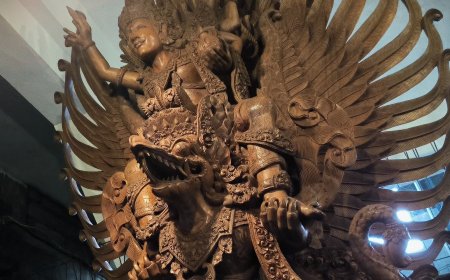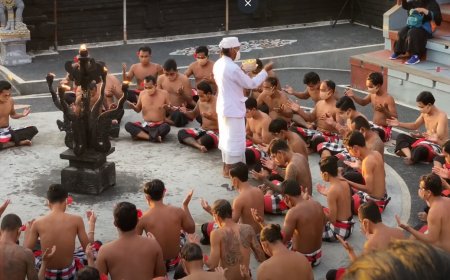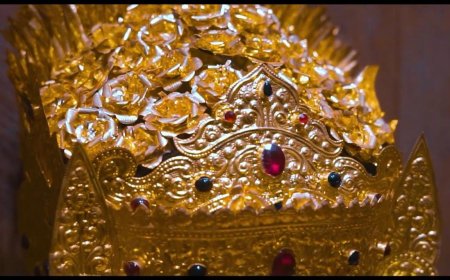Gabor Batubulan Dance : Exploring Traditions As Ancestral Assets
Batubulan Gabor Dance, a typical Balinese dance art, is often performed in religious ceremonies with a graceful look, accompanied by special music known as Legod Bawa. In addition, in this tradition, there is a custom of giving food to the dancers before they perform at Pura Kahyangan Tiga Batubulan Village. Gabor dance and its entire set of traditions are a valuable part of Bali's priceless cultural heritage, bringing with it traditional values and contributing to enriching the cultural richness of Indonesia, particularly on the island of Bali.
Talking about the island of Bali, it's incomplete if you don't talk about its dance. Balinese dance itself is a dance art form that has become a rich, expressive, and varied cultural heritage. It is often used as a tool to communicate stories, myths, history, or feelings in a variety of situations, including in religious ceremonies, art performances, and cultural events. Besides being an integral part of Indonesian culture, Balinese dance also attracts the main attention of tourists visiting Bali, as well as being a way for the Balinese people to maintain and inherit their traditions that have existed for centuries. One of them is the Gabor Dance from Batubulan Village, Gianyar.
Batubulan Village Gabor Dance is an original dance art originating from Batubulan Village and has its own characteristics. Unlike the usual Gabor dance which is used as a welcome, this dance is included in the guardian dance which aims to pay homage to Ida Sanghyang Widhi Wasa. The Batubulan Village version of Gabor Dance is performed in the piodalan and pujawali ceremonies at Pura Kahyangan Tiga Batubulan Village. During its performance, this Gabor dance is accompanied by traditional Balinese musical instruments, namely Gong Kebyar gamelan, which is also part of Balinese musical art.
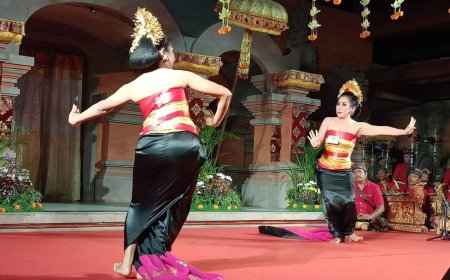
Performance of Gabor Dance Typical of Batubulan Village (Source : Private Collection)
The characteristic of Batubulan Village style Gabor dance is its subtle elegance, which depicts the beauty in this dance. In addition, the musical accompaniment of Gabor dance also has a characteristic that distinguishes it from ordinary Gabor dance, namely the use of gending legod bawa. This music is played in the pengawak section of this Gabor dance. This Gabor dance accompaniment music is specifically used to support the performance of Batubulan Village style Gabor dance in the context of piodalan and pujawali ceremonies at Pura Kahyangan Tiga Batubulan Village.
During religious ceremonies, such as Dewa Yadnya at certain piodalan or large piodalan in Batubulan Village, there is a procession known as the mekecan-kecan ceremony. This procession is accompanied by a sound called tabuh gegaboran. This triggers spontaneous participation from local residents who want to take part in the presentation of the dance as a tribute, which is accompanied by the sound of the gegaboran drum. From here, the tradition of Gabor dance was passed down and preserved until today. However, there is no record of the year when Batubulan-style Gabor dance first appeared, and the original creator of this Gabor dance remains anonymous.
Gabor dance itself has a variety of types that are rarely or even rarely performed during temple ceremonies or piodalan. In Batubulan Village, there are several types of Gabor dance, such as Gabor Ileh-Ileh, Gabor Prabangsa, Gabor Mearas-sarasan, and Legod Bawa. However, the most commonly performed is Gabor Legod Bawa. These types of Gabor dance have names according to the type of music used in their performances.
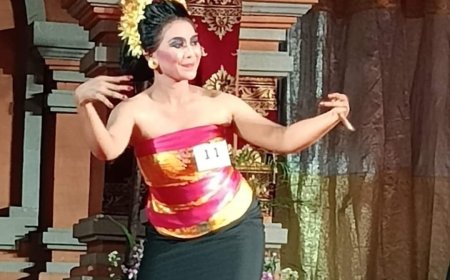
Typical Batubulan Gabor Movement (Source : Private Collection)
Uniquely, in Batubulan Village there is also a tradition where they give rice tip to dancers who will perform ngaturang ayah (dancing) at the temple. The purpose of this tradition is to help dancers prepare themselves before performing ngaturang ayah (dancing) on the piodalan day. Therefore, this tradition is still maintained until today, giving Gabor dancers the privilege of food, and until now, this tradition is still carried out well.
This Gabor dance utilizes a gending called Legod Bawa in its escort, which has unique characteristics that separate it from regular Gabor dance. Legod Bawa is a type of music that is usually used in the gamelan ensemble Gong Kebyar. The structure of Legod Bawa consists of 16 strokes of jublag, 4 strokes of jegogan, 1 stroke of kenong, and 2 strokes of kempul in one set of gongan.
When viewed from its structure, the Batubulan Village Gabor dance accompaniment consists of four main parts, namely: Pepeson, Pengawit, Pengawak, and Pekaed. Pepeson acts as the opening part used to introduce the character of a character through medium tempo movements. Then, Pengawit becomes the initial or preliminary part of the Balinese musical composition. Furthermore, Pengawak is the middle part of the Balinese musical composition, and Pekaed is the last part in the Balinese dance structure.

Gamelan that accompanies the dance (Source : Private Collection)
Pepeson is the initial part of the Balinese dance structure that serves to introduce the character of a character through medium tempo movements. In this Gabor dance accompaniment, the initial part begins with the batel gegaboran motif played by all Gong Kebyar instruments such as kendang, kecek, ceng-ceng kopyak, ugal, pemadé, kantilan, kajar, gong, kempur, kemong, reyong, penyacah, jublag, and jegogan. When the dancers enter the temple circle or courtyard, the batel gegaboran music stops.
It is followed by Pengawit which is the beginning or preliminary part of the Balinese musical composition in Gabor dance accompaniment. In this Gabor dance accompaniment, the pengawit section adopts the legod bawa music. It starts with the ugal instrument, followed by the jegogan instrument and kendang wadon with a single kendang gupekan motif. Then, all instruments are struck simultaneously with the same pitch, except for the kajar, kemong, and kempur instruments.
Next, in the Pengawak section, is the middle section of a Balinese musical composition. In the Pengawak section of this Gabor dance accompaniment, the gending legod bawa is used, which has a long musical structure with 8x4 beats. Instruments such as pemadé, kantilan, and reyong are played with the norot punch technique, while on the drum instrument, the gupekan single drum motif is used.
The last part of the Gabor dance accompaniment structure of Batubulan Village is Pekaed. In the Gabor dance accompaniment, the Pekaed section again presents the batel gegaboran motif played by all Gong Kebyar instruments such as kendang, kecek, ceng-ceng kopyak, ugal, pemadé, kantilan, kajar, gong, kempur, kemong, reyong, penyacah, jublag, and jegogan. After the dancers leave the circle or temple courtyard, the batel gegaboran music is then stopped.
Therefore, the Batubulan Village Gabor Dance and the traditions that accompany it are valuable assets in enriching Balinese culture and inheriting traditional values that have existed for centuries. May this tradition continue and be well preserved as an important part of Indonesia's cultural heritage, especially Bali.





















































